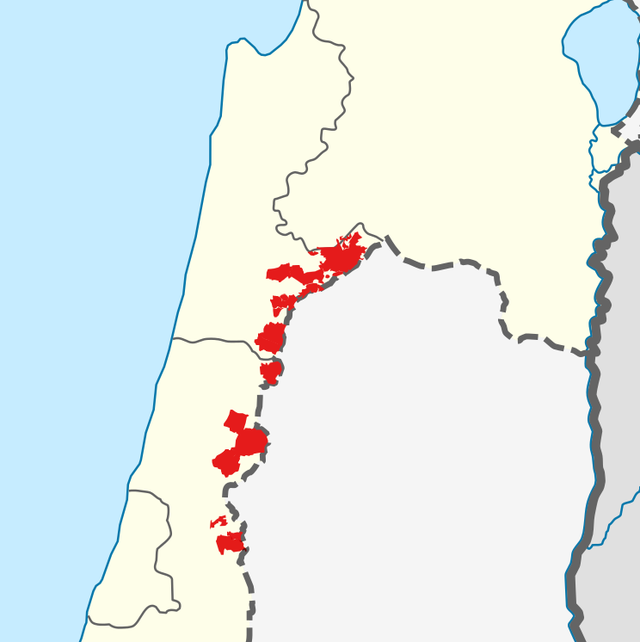Triangle (Israel)
Arab-Israeli towns along the Green Line From Wikipedia, the free encyclopedia
Arab-Israeli towns along the Green Line From Wikipedia, the free encyclopedia
The Triangle (Hebrew: המשולש, HaMeshulash; Arabic: المثلث, al-Muthallath), formerly referred to as the Little Triangle, is a concentration of Israeli Arab towns and villages adjacent to the Green Line, located in the eastern Sharon plain among the Samarian foothills; this area is located within the easternmost boundaries of both the Central District and Haifa District. The eleven towns are home to approximately 250,000 Arab citizens of Israel, representing between 10-15% of Israel's Palestinian Arab population.[2]


The Triangle is further divided into the "Northern Triangle" or Wadi Ara[3] (around Kafr Qara, Ar'ara, Baqa al-Gharbiyye, Zemer and Umm al-Fahm) and the "Southern Triangle" (around Qalansawe, Tayibe, Kafr Qasim, Tira, Kafr Bara and Jaljulia). Umm al-Fahm and Tayibe are the social, cultural and economic centers for Arab residents of the region. The Triangle is a stronghold of the Islamic Movement in Israel and Raed Salah, the current leader of the movement's northern faction, is a former mayor of Umm al-Fahm.
Prior to the 1948 Arab–Israeli War and Israel's establishment and sovereignty over the Kafr Qasim, Jaljulia and Kafr Bara area, it was referred to as the "Little Triangle" to differentiate it from the original larger "Triangle" region between Jenin, Tulkarm, and Nablus.[1] The original triangle was dubbed by the British the "Triangle of Terror" or "Triangle of Fear", during the 1936–1939 Arab revolt in Palestine.[1]
The region was originally designated to fall under Jordanian jurisdiction, but while negotiating the 1949 Armistice Agreements, Israel insisted on having it within its side of the Green Line, for military and strategic reasons. To achieve this, a territorial swap was negotiated, ceding the Israeli territory in the southern hills of Hebron in exchange for the Triangle villages in Wadi Ara.[4][5] The term was later expanded to include the entire area around Wadi Ara (the Northern Triangle of today) and the "Little" appendage quickly fell out of common use.
Populations as of 2022 are as follows:[6]
The concept of stripping the citizens of the area of their citizenship of Israel has been mooted. Several Israeli politicians have suggested the Triangle should be transferred to a future Palestinian state in exchange for Israel retaining control over settlements in the West Bank. The idea is a major part of the Lieberman Plan put forward by Yisrael Beiteinu leader Avigdor Lieberman but is largely opposed by Israeli Arabs.[7] It is also a key feature of the Trump peace plan, which stated:
The Triangle Communities consist of Kafr Qara, Ar’ara, Baha al-Gharbiyye, Umm al Fahm, Qalansawe, Tayibe, Kafr Qasim, Tira, Kafr Bara and Jaljulia. These communities, which largely self-identify as Palestinian, were originally designated to fall under Jordanian control during the negotiations of the Armistice Line of 1949, but ultimately were retained by Israel for military reasons that have since been mitigated. The Vision contemplates the possibility, subject to agreement of the parties that the borders of Israel will be redrawn such that the Triangle Communities become part of the State of Palestine. In this agreement, the civil rights of the residents of the triangle communities would be subject to the applicable laws and judicial rulings of the relevant authorities.[8]
In a July 2000 survey conducted by Kul al-Arab among 1,000 residents of Umm al-Fahm, 83 percent of respondents opposed the idea of transferring their city to Palestinian jurisdiction.[9]
Seamless Wikipedia browsing. On steroids.
Every time you click a link to Wikipedia, Wiktionary or Wikiquote in your browser's search results, it will show the modern Wikiwand interface.
Wikiwand extension is a five stars, simple, with minimum permission required to keep your browsing private, safe and transparent.